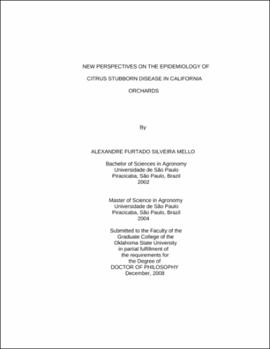| dc.contributor.advisor | Fletcher, Jacqueline | |
| dc.contributor.author | Mello, Alexandre Furtado Silveira | |
| dc.date.accessioned | 2013-11-26T08:23:47Z | |
| dc.date.available | 2013-11-26T08:23:47Z | |
| dc.date.issued | 2008-12 | |
| dc.identifier.uri | https://hdl.handle.net/11244/6746 | |
| dc.description.abstract | Scope and Method of Study: | |
| dc.description.abstract | California is the major citrus fresh fruit producer in the US and citrus stubborn disease (CSD), caused by Spiroplasma citri, has been present in that state for a long period of time. CSD impact and epidemiology are not fully understood or quantified limiting the possibilities for science based management strategies. In this study, we evaluated symptom severity, disease incidence, pathogen diversity, and pathogen titer in symptomatic trees, thereby providing information useful to the improvement of disease management. | |
| dc.description.abstract | Findings and Conclusions: Incidence of CSD in two commercial citrus orchards varied from low to high. Citrus fruit receptacles were more suitable than other tissues for spiroplasma cultivation. Molecular comparison of S. citri strains from different citrus orchards, carrot fields and weeds, collected from 1980 to 2007, showed that S. citri populations have a high degree of genetic variability, but strain identities were not correlated with the date or location of collection. | |
| dc.description.abstract | A two year field evaluation in one commercial sweet orange orchard showed that CSD severely symptomatic trees had a smaller tree canopy and yielded less fruit than mildly symptomatic trees. Fruits produced on severely symptomatic trees were also smaller, and more of them had sunburn than fruits from mildly symptomatic or healthy trees. Using a variety of molecular markers, no genetic differences were detected between S. citri strains from severely symptomatic trees and mildly symptomatic trees. However, bacterial titer, quantified by q-PCR, was higher in severely symptomatic than in mildly symptomatic trees. | |
| dc.description.abstract | The natural vector of S. citri, Circulifer tenellus, was able to acquire and transmit S. citri strains from feeding sachets to carrot plants, confirming the spiroplasma as the causal agent of carrot purple leaf disease. No strain-host specificity was identified. | |
| dc.format | application/pdf | |
| dc.language | en_US | |
| dc.rights | Copyright is held by the author who has granted the Oklahoma State University Library the non-exclusive right to share this material in its institutional repository. Contact Digital Library Services at lib-dls@okstate.edu or 405-744-9161 for the permission policy on the use, reproduction or distribution of this material. | |
| dc.title | New perspectives on the epidemiology of citrus stubborn disease in California orchards | |
| dc.contributor.committeeMember | Wayadande, Astri Cassandra | |
| dc.contributor.committeeMember | Bender, Carol L. | |
| dc.contributor.committeeMember | Melcher, Ulrich | |
| osu.filename | Mello_okstate_0664D_10016.pdf | |
| osu.accesstype | Open Access | |
| dc.type.genre | Dissertation | |
| dc.type.material | Text | |
| dc.subject.keywords | plant disease | |
| dc.subject.keywords | plant mollicute | |
| dc.subject.keywords | Spiroplasma citri | |
| dc.subject.keywords | vascular pathogens of citrus | |
| thesis.degree.discipline | Entomology and Plant Pathology | |
| thesis.degree.grantor | Oklahoma State University | |
